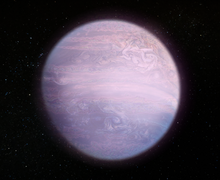Super-puff

A super-puff is a type of exoplanet with a mass only a few times larger than Earth's but with a radius larger than that of Neptune, giving it a very low mean density.[1] They are cooler and less massive than the inflated low-density hot-Jupiters.[1]
The most extreme examples known are the three planets around Kepler-51 which are all Jupiter-sized but with densities below 0.1 g/cm3.[1] These planets were discovered in 2012 but their low densities were not discovered until 2014.[2] Another example is Kepler-87c.[1]
One hypothesis is that a super-puff has continuous outflows of dust to the top of its atmosphere (for example, Gliese 3470 b), so the apparent surface is really dust at the top of the atmosphere.[2] Another possibility is that some of the super-puff planets are smaller planets with large ring systems, like HIP 41378 f.[3]
References
[edit]- ^ a b c d The Featureless Transmission Spectra of Two Super-Puff Planets, Jessica E. Libby-Roberts, Zachory K. Berta-Thompson, Jean-Michel Desert, Kento Masuda, Caroline V. Morley, Eric D. Lopez, Katherine M. Deck, Daniel Fabrycky, Jonathan J. Fortney, Michael R. Line, Roberto Sanchis-Ojeda, Joshua N. Winn, 28 Oct 2019
- ^ a b "Astronomers Confirm the Existence of Planets That Have the Lightness of Cotton Candy". 20 December 2019.
- ^ "These So-Called 'Super-Puff' Worlds Could Be Exoplanets with Rings". Discover Magazine. Retrieved 11 January 2020.


